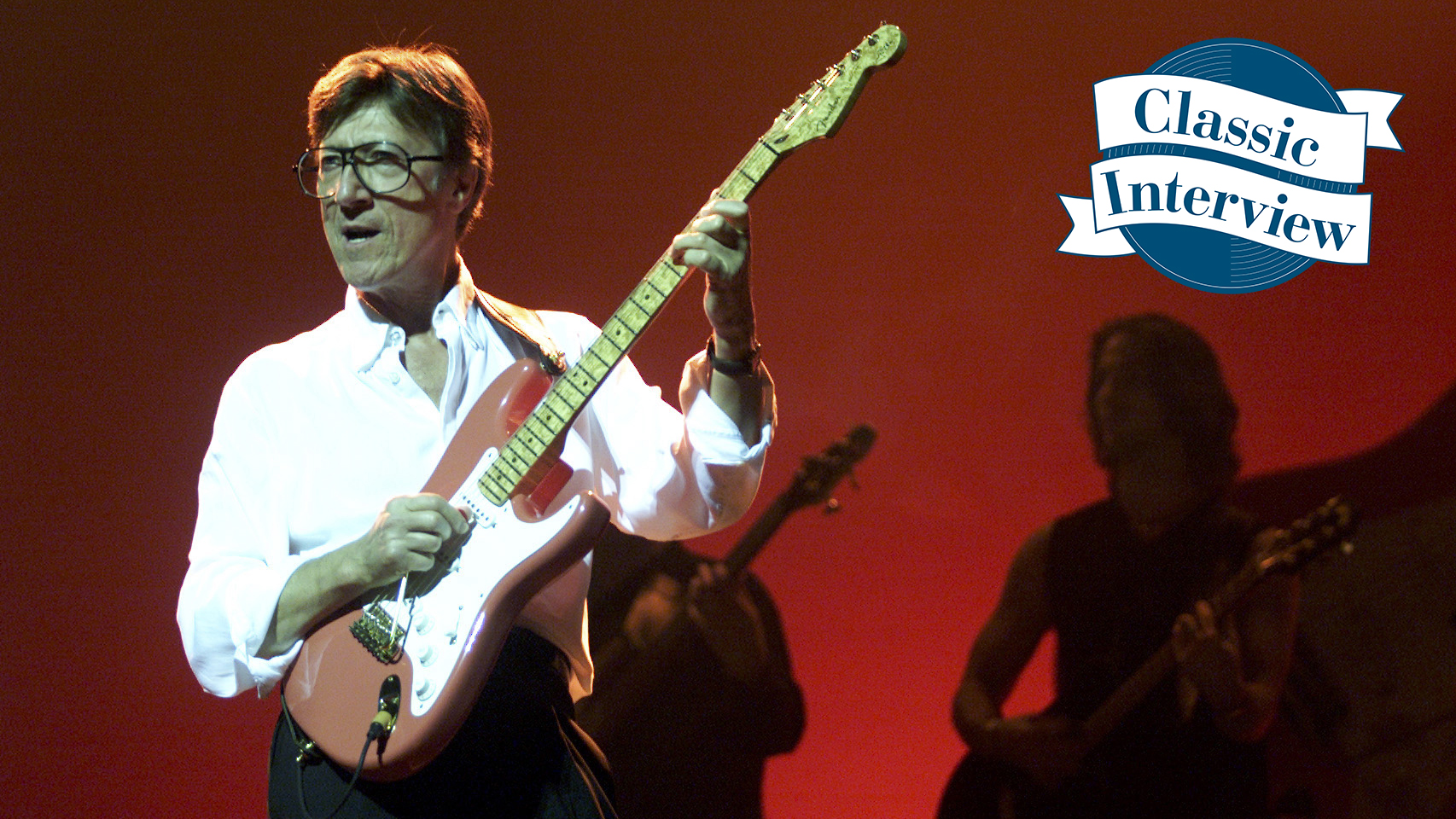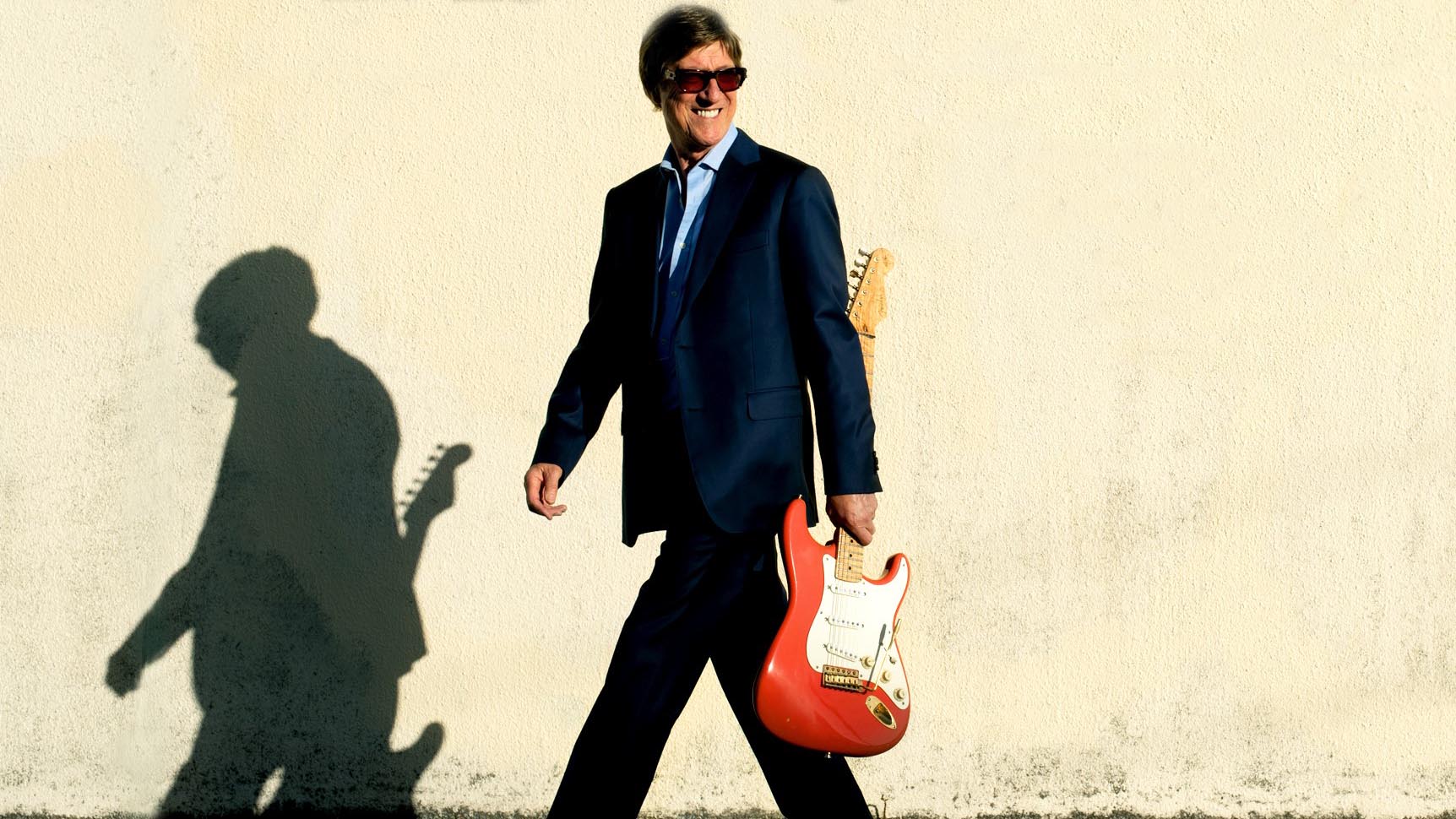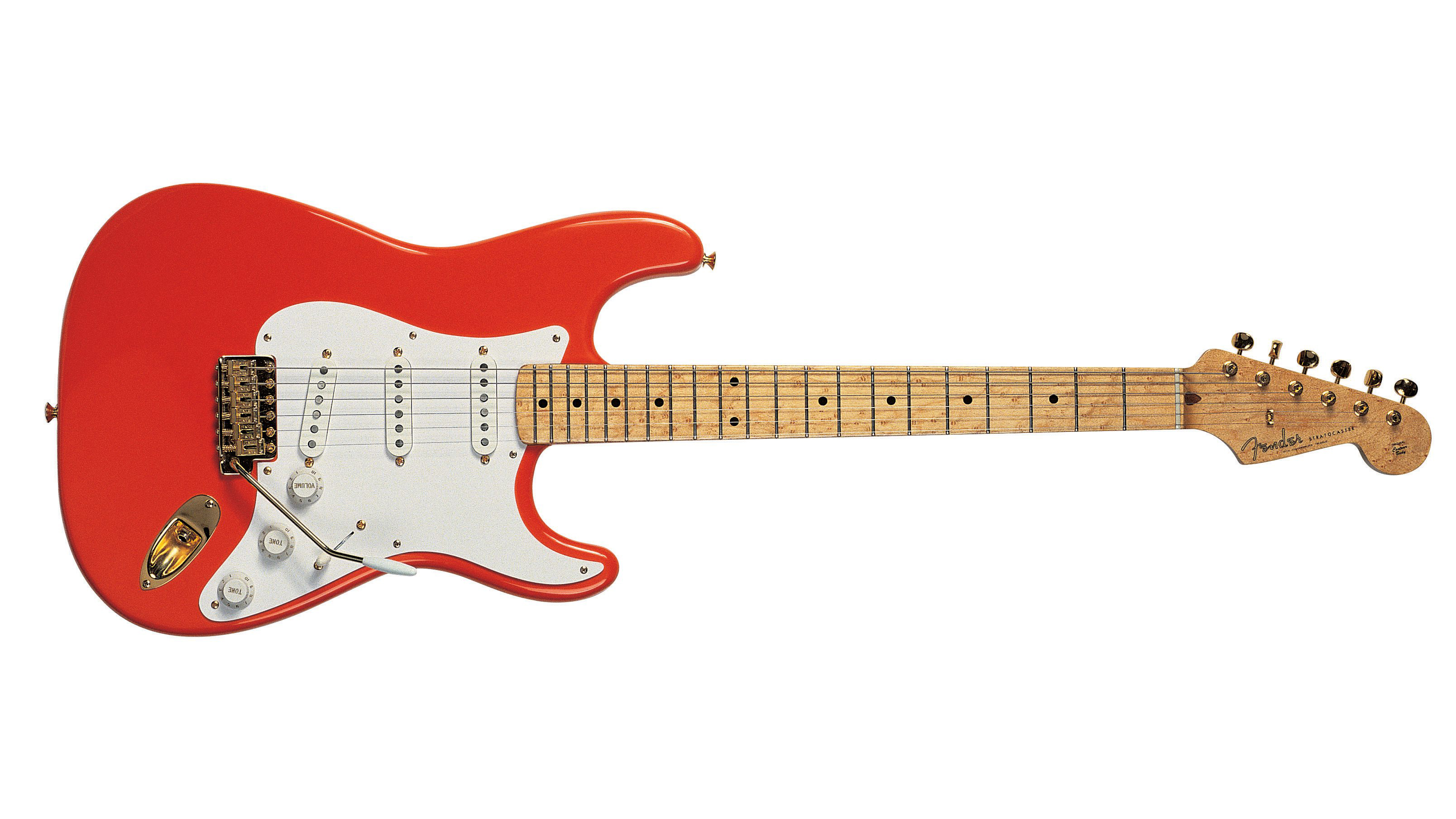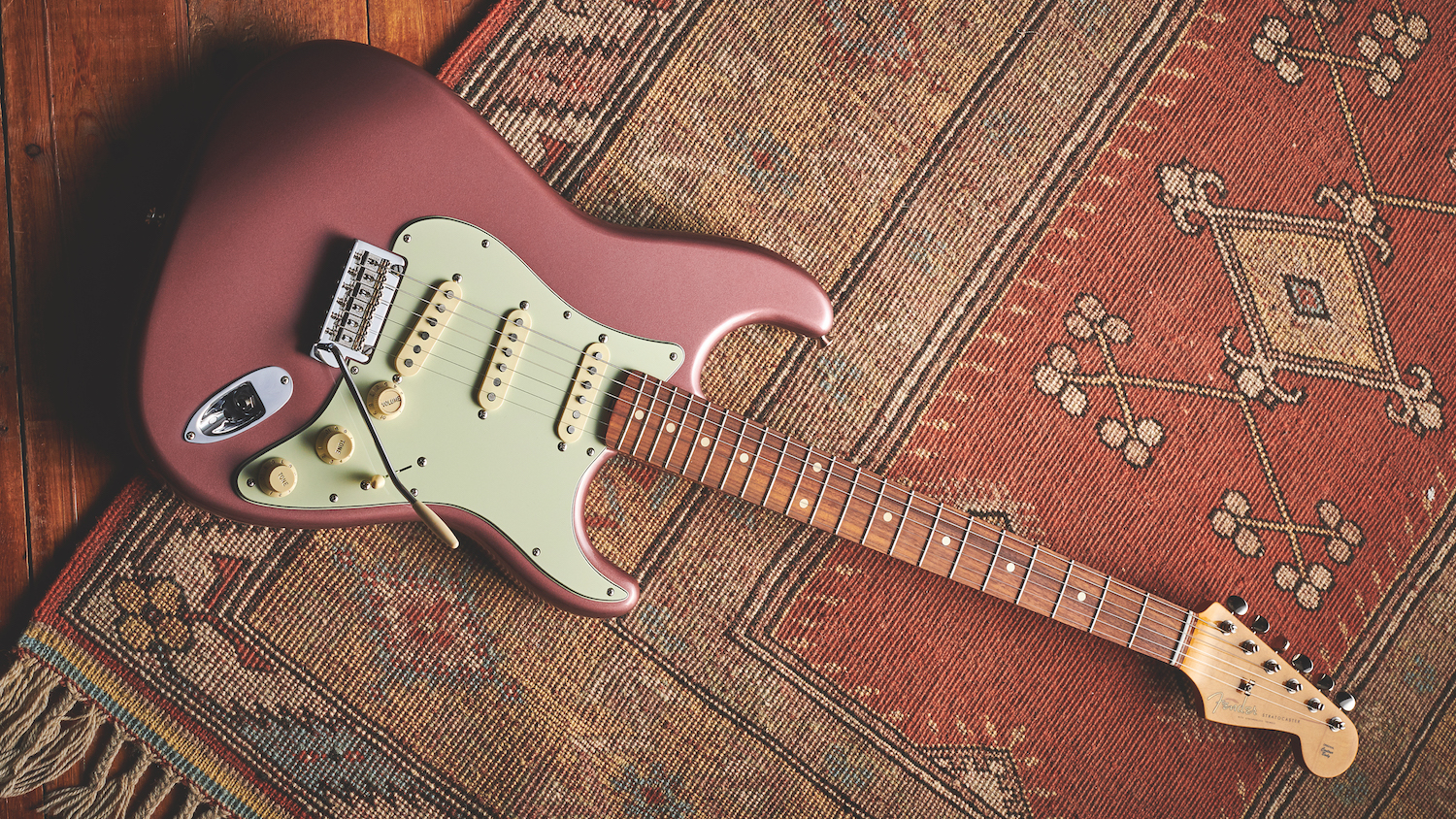"It was like something from space" – Hank Marvin talks in-depth about the Strat
Classic interview with the Shadows' guitar hero

This classic interview from 2014 doesn't just shine a light on a Strat icon, it's in remembrance of interviewer and Shadows expert Roger Newell, who passed away last year, age 73.
As well as a valued contributor to Guitarist magazine for years, Roger was a respected bassist, playing on Rick Wakeman's 1974 epic, Journey to the Centre of the Earth, as well as its follow-ups, The Myths and Legends of King Arthur and the Knights of the Round Table and No Earthly Connection. He was also a member of cult psychedelic pop outfit Rainbow Ffolly and played in Marty Wilde's touring band, The Wildcats.

Few Strat players are as iconic as Hank Marvin – it’s hard to picture him without also seeing in your mind’s eye a Fiesta Red Strat with a maple fingerboard and gold-plated fittings, the guitar with which he made his name in The Shadows.
It’s a guitar that seemed electrifyingly modern in drab, post-war Britain, and in fact, it was the first example of Leo Fender’s contoured masterpiece to enter the country. It’s testament to the Strat’s adaptability that Hank’s still relying on the design decades later – and over the years, several other Strats have passed through the hands of this hugely influential player.
As Hank prepares to cut a new album, we caught up with him to chat about the ‘significant other’ Strats that he’s used on landmark recordings over the years, plus detailed insights into the Strat setup and component mods that he favours..

We decided that the Fender was the way to go, because we’d seen Buddy Holly with one on the Crickets album cover
So, that first Fiesta Red Strat. How did you come by it?
“That first Strat made an appearance in 1959. My Antoria had a horribly bent neck, so Cliff wanted to buy me a good guitar. We decided that the Fender was the way to go, because we’d seen Buddy Holly with one on the Crickets album cover, and it was pretty cool.
"It was great looking, and we liked the sound of it, and we’d heard that James Burton used a Fender, so we got a catalogue from the States. We could see that Buddy’s guitar was the Stratocaster and as that was their top-of-the-range model, we assumed that James Burton would also have one. For some reason, we always thought it was called Flamingo Pink. But apparently they never had any such colour; it was Fiesta Red – anyway, we ordered that in what was pretty much the top-of- the-range specification.”
Want all the hottest music and gear news, reviews, deals, features and more, direct to your inbox? Sign up here.
Its arrival must have been exciting?
“Very! It came in a tweed Fender case with the red plush lining and this magnificent-looking thing was just lying inside. It was like something from space, really, it was so futuristic in its design. The three pickups, the white scratchplate, the red guitar, the beautiful birdseye maple neck and all the gold plating, it just looked sensational.
"We just looked at it for a while, then took it out of the case, tuned it up and played it. Unfortunately, the strings were really heavy; I was told back in the '70s that they were sent out then with 0.013 to 0.056 gauge or something like that, with a 0.026 wound third, so they were much heavier than I was used to. I found it difficult to adjust to the effort.”
So what was the first recording session you used it on?
“I’m not sure about that. Saturday Dance [from August 1959 – Ed] has the Strat on it, and I used it on Cliff ’s second album [Cliff Sings]. We did things like The Snake And The Bookworm, but I don’t remember which came first, that album or Travellin’ Light.”
Is it true that the vibrato arm was particularly short?
“Well, I didn’t have anything initially to compare it with, but I noticed that some of the Strats I had later seemed to have longer arms. So I would say that it was shorter. It would be interesting to compare photographs.”
That particular guitar went back to Cliff, and he had it sprayed white for a while?
“Yeah, well, when Jennings [Vox’s manufacturers – Ed] became the importers of Fender equipment once the trade embargo was lifted, they wanted us to use Fenders. Initially, I still had that first guitar, so Bruce [Welch] and Jet [Harris] got the Jazzmaster and Precision Bass. Then they said we could have red Strats and a bass, and we thought great, that would be a good look. They gave me one as well with a rosewood fingerboard, so the original went back to Cliff. That would have been 1961, and I think we had them sprayed white for a while.
"I know we had white Burns guitars, but before that, we had white Fenders during the time that Licorice [Brian Locking] was playing bass. We didn’t have the red ones as well, so I think they took them back and sprayed them for us. Cliff liked the look of them, so he said: ‘I’ll get this one sprayed white, so when we’re working together and I use it, it’ll look really cool’.”
What were the first recordings the rosewood Strat was on?
“The first session? Good question, but I can’t remember! When we did the Crackerjack TV show playing The Frightened City and FBI [in late April 1961] we had those guitars, but we didn’t necessarily record and release things immediately. It could have been two weeks later, or a track could have been sitting around for months.”
I preferred the maple neck; it was a better guitar
So which did you prefer at the time, the maple-neck Strat or the rosewood ’board?
“I preferred the maple neck; it was a better guitar, I thought, with a particularly good sound. When I got the rosewood ’board, it just sounded a bit different to me. And I just preferred the feel of that original guitar, which was a particularly nice instrument with a nice fingerboard.”
Did you get a choice of the guitars that Jennings supplied?
“No, they would just send them over. We just thought a Strat’s a Strat, and if there was a problem they would obviously fix it – you know, rough frets or anything like that – but we didn’t get to choose them ourselves; they picked out two guitars and a bass for us.
"There were at least two, maybe three sets going through from then until 1963. They replaced them as necessary. We did get newer guitars as ours got a bit bashed or whatever, and they’d take those back and do whatever they do with them, probably renovated and sold them, I guess.”

As you preferred the feel, why didn’t you go back to an all-maple neck?
“Well, I asked, and they said they couldn’t get the maple necks. Whether Fender had stopped making them at that point I’ve really no idea, but that’s the story we were told and accepted.”
How much of a problem was noise in the early days?
“It depended on the venue, particularly when they used the dimmers on the lights, as that seemed to affect the noise tremendously – it was really ‘frying tonight’. Once you were all playing, it wasn’t really that noticeable, but back then, people’s sound quality expectations weren’t what they are now.”
So are you still favouring Kinman pickups on the Stratocasters that you use today?
“When we did the remake of all the old numbers for the Cliff and The Shads reunion album, I decided to try out some of the Fender ’57 reissues, which I was introduced to when trying out the TVS3 echo. I thought it might be an idea to go back to the kind of pickups on the older guitars to get the sort of sound that we were trying to recreate. I had those fitted on all the guitars for the album, and they’re still on! They sound really good. They have a nice twang to them, and although they’re not as quiet as the Kinmans, they’re not as bad as they used to be.”
Why did you decide to switch back to Fender guitars from Burns instruments after Marvin, Welch & Farrar reverted to being The Shadows?
“Well, I’d already gone back to Fenders by then. When Marvin, Welch & Farrar were doing the Palladium with Cliff and Olivia Newton John, I had several guitars stolen – two Burns, a 12-string Gibson and an acoustic six-string – on the night before we opened.
"Bruce had lent Cliff ’s [now white] Strat to Terry Britten, who was in Cliff ’s band at the time, so he got it back for me. I used it for the time we were there, then I decided, yeah, I love it, I’m back on to the Strat! So that’s when I bought the Sunburst one, or one with that terrible colour that looked like an undercoat, but anyway, I bought a Strat. I should have kept hold of Cliff ’s one!”
During the time that you were working with John Farrar, there was a Sunburst Strat with a maple ’board and large headstock and a much-modified white one...
“I had a black one! But, from memory, I had that sprayed at least once so that was probably the Sunburst one that I decided to have black, eventually with a tortoiseshell pickguard. I tried different pickups, too. I had a Fender humbucker on the bridge and something else on the front, a Gibson humbucker, I think, and a single coil. Actually, I still have that scratchplate in the studio with the pickups attached. I saw a black Telecaster in a guitar store in Manchester, and thought it looked really sharp, so I decided to do it black, and I had it for a few years until I gave it to Ben Marvin.”
I do use that between- pickups sound sometimes, just for a tone colour change, but usually, I use the pickups individually – and more often than not, I end up on the bridge pickup”
Do you have any wiring mods done to your Strats?
“Well, a few extra switches in the days when you tried to get those in-between pickups sounds, but I think that was on the one with the humbuckers. On one of my signature models, I’ve got a pull/push switch on the lower tone-control knob which does something, although I’m not sure what, as I’ve never used it! I think it engages the neck and bridge pickup together, and I think that’s why I had it done.
"That’s quite an interesting sound, and I’m pretty sure I used that on a couple of my early album tracks, although it doesn’t figure very highly on my Richter Scale of pickup choices – but you’ve just reminded me that maybe I should look at that again. I do use that between- pickups sound sometimes, just for a tone colour change, but usually, I use the pickups individually – and more often than not, I end up on the bridge pickup.”
They got it right first time!
Do you still have Easy-Mute vibrato arms on your Strats?
“Yes, I do, along with the block that Ian St John White does that matches the actual bar. The material it’s made of stops the bar working loose like the standard arm tends to do. We’ve all tried tape and loads of things to stop that rattle, but these never do that, they’re brilliant.”
Let’s be honest, there wasn’t actually much wrong with the original 1954 design, was there?
“No, not at all! I’ve seen a ’54 belonging to a friend of mine in France, Jean-Pierre Danel, who’s got one that he calls Miss Daisy, and it’s very nice. Whew! Great design – looked great, comfortable to play... they got it right first time!”
It’s totally functional, beautiful and iconic at the same time...
“Absolutely! And it’s a very practical instrument, too. They’re as tough as old nails and you’ve got a variety of sounds available. I’ve seen people playing jazz on them; you can play country on them, blues, rock, heavy rock and everything you can think of, really. I think it’s an incredibly versatile guitar.”